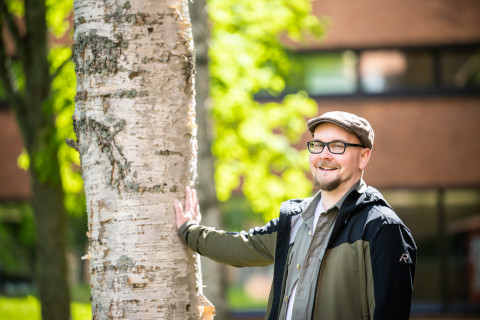Is climate change a cause of concern for the silver birch in Finland? According to Antti Tenkanen, PhD, the answer is no, as the silver birch is capable of acclimating to changing conditions.
Antti Tenkanen’s doctoral research focused on silver birch trees originating from different latitudes across Finland and, using both field and growth chamber experiments, he explored their traits and capacity to acclimate and adapt to climate change. The topic is very popular at the moment, and carbon sequestration and tree growth are getting plenty of attention– also beyond academia.
Tenkanen’s choice of a research topic was made easy by the fact that at the time, the UEF Plant Ecophysiology Group was running an extensive silver birch experiment in three field locations across Finland. Researchers were growing hundreds of silver birch seedlings originating from six different latitudes, and the trees were clonally reproduced with tissue culture methods from several different mother trees.
“This was an impressive experiment, even by international comparison. Research into this topic has been conducted already before, but in addition to the climate change perspective, we now included the effect of photoperiodism at different latitudes,” Tenkanen says.
Birch trees are less used in research than conifers. The silver birch, however, is very well known to research, so it serves as a model organism. Its entire genome was mapped a few of years ago.
“The silver birch grows and flowers fast, and it is easy to replicate in tissue cultures,” Tenkanen says.
In the growth chamber experiments, silver birch trees from Punkaharju and Kittilä, southern and northern Finland, were used. In the first experiment, they were grown under similar conditions, and the second experiment explored their responses to photoperiod. The researchers also monitored their growth and biomass, carbon sequestration and photosynthesis.

Since some research on the topic had been carried out already before, the researchers had some expectations – or rather ideas or assumptions – about the results.
The word “expectation” gives Tenkanen some pause.
“In science, words and their meanings matter. Expectations should not guide the interpretation of results, nor the direction of research,” he says.
“We assumed that birches of different provenances would have different growth strategies, and we analysed them from the provenances included in the study. Based on literature, we were able to make some hypotheses, which we then got to test in controlled growth chamber experiments.”
There were clear differences between the birches. For birches exposed to the polar day of Lapland, the growing season is short and cool, but light is continuously available. In the southern parts of Finland, summer nights include a period of darkness or twilight.
“There are differences between the north and the south in the amount and quality of light. Snow loads, too, are different, which affects how trees invest in growing branches. Meltwaters, on the other hand, are likely to affect the water dynamics of trees,” Tenkanen notes.
“Compared to southern birches, northern birches have a higher net photosynthesis and gas exchange capacity per leaf area, and their relative height growth rate was as good or even better. However, northern birches allocate biomass relatively more to their roots below ground, and due to the shorter growing season, the realised height growth is weak.”
We coined a new word to describe the traits of the northern provenances: ‘polar day syndrome’.
Antti Tenkanen
PhD
But which is more important, light or temperature?
“This experiment examined leaf-level gas exchange, and temperature exposure was not part of the test design. Both light and temperature are important to plants, but in extreme conditions, such as in Lapland in the summer, the importance of light is emphasised, because that’s where the energy for photosynthesis comes from.”
According to Tenkanen, plants allocate their resources differently in the north. For trees, leaves are capital. Northern birches have fewer leaves, so they are invested in more. Pest damage may become an important issue in the future.
“We’ll see what kind of damage we’ll be dealing with in the future,” he says.
The study found differences between the geographically distant birch populations, but, surprisingly, also similarities.
“One such similarity was the photosynthesis-temperature response, as the optimal temperature was almost the same. The same was true for leaf longevity,” Tenkanen says.
“The similar traits of birches of different provenances grown under similar conditions suggest that they have acclimation capacity. Different birch provenances are well capable of acclimating to changes.”
In the future, it would be important to examine how northern provenances could benefit from the longer growing season and adapt to changing conditions in their natural site.
“The results of this study can be used to better predict birch growth and carbon sequestration. There is no need to worry about the survival of the silver birch; however, we don’t know everything about the limits of its ability to adapt and acclimate yet. Climate change comes with uncertainties and unknown risks.”


